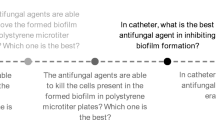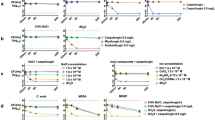Abstract
Background
The predominance of non-Candida albicans Candida (NCAC) species causing healthcare-associated infections has increased over the last decade pertaining to their ability to form biofilms on medical devices. These biofilm-associated infections are challenging to treat as they are resistant to antifungal agents and evade host-immune response resulting in a high risk of device failure or biomaterial removal. Thus, to minimize the risk of biofilm-associated infections, preventing biofilm formation is the best approach which is mediated by the quorum quenching process.
Methods
The present study investigated the modulatory effect of 2,5-dimethyl-4-hydroxy-3(2H)-furanone (DMHF) on NCAC biofilm formation and also assessed the effect of the DMHF-coated catheters on biofilm formation of NCAC. The NCAC isolates studied were Candida tropicalis, Candida glabrata and Candida krusei isolated from catheter tip, urine and blood, respectively.
Results
DMHF at a concentration of 30 µg/mL showed an inhibitory effect against NCAC biofilms at various stages and was statistically significant (p ≤ 0.05) against the various concentrations (50–5 µg/mL) tested and also among the three phases of experiment. The furanone content on coated catheters ranged from 170 to 750 µg and release of furanone from the coated catheter was about 15 µg for 30 days. The effect of DMHF-coated catheters on NCAC biofilm formation was observed by the scanning electron microscopy which revealed the absence of NCAC adherence on DMHF-coated catheters.
Discussion
This study provides a design to develop furanone-coated biomaterials which could be implemented in healthcare settings to reduce medical device-associated infections. The excellent biological performance, combined with their antimicrobial properties, suggests that 2,5-dimethyl-4-hydroxy-3(2H)-furanone could be an effective anti-infective coating for implantable devices.




Similar content being viewed by others
References
Raut JS, Doke SK, Karuppayil SM. Yeast biofilms in the context of human health and disease. In: Satyanarayana T, Kunze G, editors. Yeast diversity in human welfare. Springer: Berlin; 2017. p. 137–62.
Beloin C, Fernández-Hidalgo N, Lebeaux D. Understanding biofilm formation in intravascular device-related infections. Intensive Care Med. 2017;43:443–6.
Rabin N, Zheng Y, Opoku-Temeng C, Du Y, Bonsu E, Sintim HO. Agents that inhibit bacterial biofilm formation. Future. 2015;7:647–71.
Sadekuzzaman M, Yang S, Mizan MFR, Ha SD. Current and recent advanced strategies for combating biofilms. Compr Rev Food Sci Food Saf. 2015;14:491–509.
Abedalwafa M, Wang F, Wang L, Li C. Biodegradable poly-epsilon-caprolactone (PCL) for tissue engineering applications: a review. Rev Adv Mater Sci. 2013;34:123–40.
Woodruff MA, Hutmacher DW. The return of a forgotten polymer—polycaprolactone in the 21st century. Prog Polym Sci. 2010;35:1217–56.
Ramage G, Saville SP, Wickes BL, López-Ribot JL. Inhibition of Candida albicans biofilm formation by farnesol, a quorum-sensing molecule. Appl Environ Microbiol. 2002;68:5459–63.
Paulitsch AH, Willinger B, Zsalatz B, Stabentheiner E, Marth E, Buzina W. In-vivo Candida biofilms in scanning electron microscopy. Sabouraudia. 2009;47:690–6.
Kaur R, Dhakad MS, Goyal R, Kumar R. Emergence of non-albicans Candida species and antifungal resistance in intensive care unit patients. Asian Pac J Trop Biomed. 2016;6:455–60.
Ferreira A, Prado CG, Carvalho RR, Dias KS, Dias AL. Candida albicans and non-C. albicans Candida species: comparison of biofilm production and metabolic activity in biofilms, and putative virulence properties of isolates from hospital environments and infections. Mycopathologia. 2013;175:265–72.
Azevedo AS, Almeida C, Melo LF, Azevedo NF. Impact of polymicrobial biofilms in catheter-associated urinary tract infections. Crit Rev Microbiol. 2017;43:423–39.
Sung WS, Jung HJ, Park K, Kim HS, Lee IS, Lee DG. 2,5-Dimeathyl-4-hydroxy-3(2H)-furanone (DMHF); antimicrobial compound with cell cycle arrest in nosocomial pathogens. Life Sci. 2007;80:586–91.
Schwab W. Natural 4-hydroxy-2, 5-dimethyl-3(2H)-furanone (Furaneol®). Molecules. 2013;18:6936–51.
Baveja J, Willcox MD, Hume EB, Kumar N, Odell R, Poole-Warren LA. Furanones as potential anti-bacterial coatings on biomaterials. Biomaterials. 2004;25:5003–12.
Park JH, Cho YW, Kwon IC, Jeong SY, Bae YH. Assessment of PEO/PTMO multiblock copolymer/segmented polyurethane blends as coating materials for urinary catheters: in vitro bacterial adhesion and encrustation behavior. Biomaterials. 2002;23:3991–4000.
Desrousseaux C, Sautou V, Descamps S, Traoré O. Modification of the surfaces of medical devices to prevent microbial adhesion and biofilm formation. J Hosp Infect. 2013;85:87–93.
Curtis J, Klykken P. A comparative assessment of three common catheter materials. Midland: Dow Corning Corporation; 2008.
EFSA panel on food contact materials, enzymes, flavourings and processing aids (CEF). Scientific opinion on flavouring group evaluation 99 revision 1 (FGE. 99Rev1): consideration of furanone derivatives evaluated by the JECFA (63rd, 65th and 69th meetings). EFSA J. 2015;13(11):4286.
Sivakumar P, Iyer G, Natesan L, Doble M. 3′-Hydroxy-4-methoxychalcone as a potential antibacterial coating on polymeric biomaterials. Appl Surf Sci. 2010;256:6018–24.
Baveja J, Li G, Nordon RE, Hume EB, Kumar N, Willcox MD, Poole-Warren LA. Biological performance of a novel synthetic furanone-based antimicrobial. Biomaterials. 2004;25:5013–21.
Hume E, Baveja J, Muir B, Schubert TL, Kumar N, Kjelleberg S, Griesser HJ, Thissen H, Read R, Poole-Warren LA, Schindhelm K, Willcox MD. The control of Staphylococcus epidermidis biofilm formation and in vivo infection rates by covalently bound furanones. Biomaterials. 2004;25:5023–30.
Zabetakis I, Gramshaw J, Robinson D. 2,5-Dimethyl-4-hydroxy-2H-furan-3-one and its derivatives: analysis, synthesis and biosynthesis—a review. Food Chem. 1999;65:139–51.
Acknowledgements
The authors wish to thank Dr. Nalini, Professor of Biochemistry, Kasturba Medical College, Manipal Academy of Higher education, Manipal, for facilitating spectrophotometry studies, Ms. Chaitra, Postgraduate, Department of Pharmaceutics, Manipal College of Pharmaceutical Sciences, Manipal Academy of Higher Education, Manipal, for the coating studies and Ms. Supreetha, Technical Assistant, Manipal University Technology Business Incubator, Manipal Academy of Higher Education, Manipal, for scanning electron microscopic studies.
Funding
This research did not receive any specific grant from funding agencies in the public, commercial or not-for-profit sectors.
Author information
Authors and Affiliations
Contributions
MB conceived of study; SMD and UYN designed study; SMD, UYN and RM performed research and analyzed data, MB and MHH contributed new methods; and SMD, UYN and MB wrote the paper.
Corresponding author
Ethics declarations
Conflict of interest
The authors declare that they have no conflict of interest.
Ethical Approval
This article does not contain any studies with human participants or animals performed by any of the authors.
Additional information
Publisher's Note
Springer Nature remains neutral with regard to jurisdictional claims in published maps and institutional affiliations.
Handling Editor: Celia Maria de Almeida Soares.
Rights and permissions
About this article
Cite this article
Devadas, S.M., Nayak, U.Y., Narayan, R. et al. 2,5-Dimethyl-4-hydroxy-3(2H)-furanone as an Anti-biofilm Agent Against Non-Candida albicans Candida Species. Mycopathologia 184, 403–411 (2019). https://doi.org/10.1007/s11046-019-00341-y
Received:
Accepted:
Published:
Issue Date:
DOI: https://doi.org/10.1007/s11046-019-00341-y




